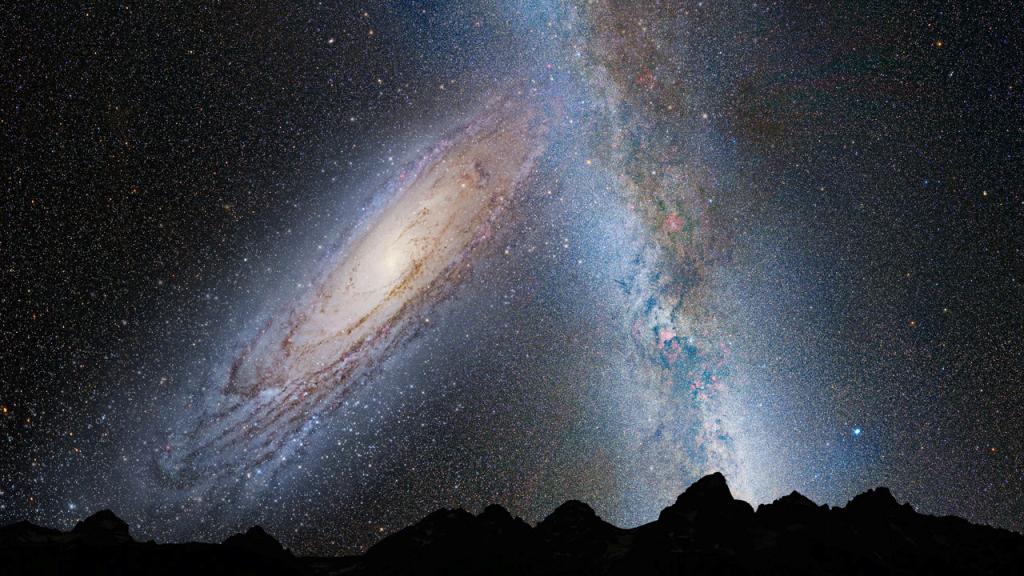Forget killer asteroids and nuclear annihilation — Earth’s ultimate fate may hinge on a cosmic coin toss.
Astronomers have revealed that our Milky Way galaxy has a 50/50 chance of colliding with its massive neighbor, the Andromeda galaxy, sometime in the next 10 billion years — an intergalactic smash-up that could fling our solar system into deep space or swallow Earth whole.
Cue the sci-fi panic — or not.
“It used to appear destined to merge with Andromeda forming a colossal ‘Milkomeda,’” said Professor Alis Deason, a computational cosmologist at Durham University, per The Daily Mail.
“Now, there is a chance that we could avoid this fate entirely.”
In other words: The end of the world may not be as inevitable as we thought — at least not from the galaxy next door.
The new study, published in “Nature Astronomy,” analyzed 100,000 simulations of the Milky Way’s future.
The findings — thanks to refined data from NASA’s Hubble Space Telescope and the European Space Agency’s Gaia mission — dramatically downshifted previous predictions of a guaranteed galactic pile-up in just 5 billion years.
“In short, the probability went from near-certainty to a coin flip,” lead author Dr. Till Sawala, of the University of Helsinki, revealed to Space.com.
The findings factor in the gravitational tug of neighboring galaxies — most notably the Large Magellanic Cloud, a much smaller satellite galaxy whose pull may be yanking the Milky Way off a crash course.
“The main difference between our research and previous studies is that we benefited from newer and more precise data, and that we considered a more complete system,” Sawala said to the site.
While a 220,000 mph galaxy-on-galaxy collision sounds catastrophic, astronomers say a head-on impact is “very unlikely.”
In fact, only 2% of simulations showed a direct hit within 5 billion years. Most scenarios had the galaxies swirling toward each other, possibly merging much later — or not at all.
Still, if they do collide, it could be a literal star show.
“We see external galaxies often colliding and merging with other galaxies, sometimes producing the equivalent of cosmic fireworks,” said Durham cosmologist Professor Carlos Frenk, via The Daily Mail.
“Until now, we thought this was the fate that awaited our Milky Way galaxy. We now know that there is a very good chance that we may avoid that scary destiny.”
But even if Earth sidesteps this stellar shakedown, don’t get too comfortable.
As The Post previously reported, our sun is expected to become a bloated red giant in about 5 billion years — likely boiling away Earth’s oceans or swallowing the planet entirely.
So, yeah. Pick your apocalypse.
“If [the Milky Way-Andromeda collision] happens, it might take place after the Earth and the sun no longer exist,” Sawala told The Daily Mail.
“Even if it happens before that, it’s very unlikely that something would happen to Earth in this case.”
Translation: By the time the universe gets around to smashing the Milky Way, we’ll probably already be toast.
Still, some experts say galactic fate is more than just an astronomer’s obsession.
“The fate of our Milky Way galaxy is a subject of broad interest — not just to astronomers,” Raja GuhaThakurta of the University of California, Santa Cruz, told the Associated Press.
And while the galaxy might survive — barely — we may not.
As Sawala put it: “Of course, there is also a very significant chance that humanity will bring an end to itself still much before that, without any need for astrophysical help.”
Talk about a stellar self-own.
Read the full article here

